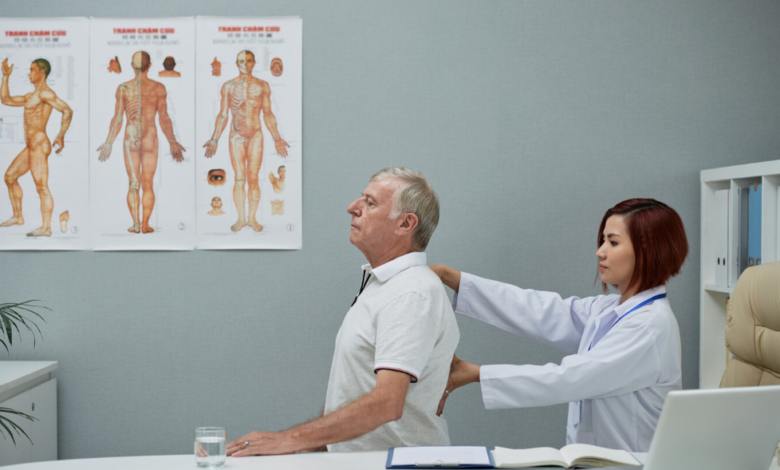How the McKenzie Method Helps Treat Back Pain Without Surgery or Medication

Understanding the McKenzie Method
The McKenzie Method, also known as Mechanical Diagnosis and Therapy (MDT), offers a unique approach to tackling back pain. It’s not just about popping pills or going under the knife; it’s about understanding why your back hurts and what you can do about it.
What is the McKenzie Method?
Developed by New Zealand physiotherapist Robin McKenzie, the McKenzie Method is a comprehensive assessment and treatment approach for musculoskeletal pain, especially back pain. It’s designed to identify the mechanical cause of your pain and empower you to manage it yourself. Unlike some therapies that focus solely on symptom relief, the McKenzie Method aims to address the root of the problem. It’s been around for over 60 years, helping people find relief from acute and chronic pain.
The Four Stages of the McKenzie Method
The McKenzie Method follows a structured process:
- Assessment: A thorough evaluation to understand your pain patterns and triggers.
- Classification: Categorizing your condition based on the assessment findings.
- Treatment: Implementing specific exercises and postures to alleviate pain.
- Prevention: Developing strategies to prevent future pain episodes.
The McKenzie Method emphasizes patient education and self-treatment. It’s not just about what happens in the clinic; it’s about giving you the tools to manage your pain at home and in the long run.
Focus on Mechanical Problems
The core idea behind the McKenzie Method is that most musculoskeletal pain stems from mechanical issues. This means that the pain is caused by how you move, sit, or position your body. By identifying the specific movements or positions that trigger your pain, a therapist can help you correct these mechanical problems and achieve lasting relief. It’s about finding the right movement to reduce or eliminate your pain. It’s a very active approach, where you are involved in your own recovery.
The Assessment Process
The McKenzie Method isn’t just about jumping into exercises. It starts with a really thorough assessment to figure out exactly what’s going on with your back. It’s like detective work for pain!
Initial Evaluation of Pain
First things first, the therapist will want to know everything about your pain. Where is it? What does it feel like? When did it start? What makes it worse, and what makes it better? They’ll ask about your medical history, too, to get the full picture. This initial chat is super important because it helps rule out other problems that might not be suitable for the McKenzie Method.
Here’s a quick rundown of what they might ask about:
- Pain location: Is it just in your back, or does it spread to your legs or arms?
- Pain type: Is it sharp, dull, achy, or burning?
- Pain behavior: Is it constant, or does it come and go?
- Anything else: Numbness, tingling, weakness?
Identifying Pain Triggers
This is where the McKenzie Method gets interesting. The therapist will have you do specific movements and hold certain positions to see how they affect your pain. They’re looking for patterns. Does bending forward make it worse? Does bending backward make it better? These movements are often repeated to really get a sense of how your body responds. It might seem a little weird, but it’s all about finding the exact movements that trigger your pain.
Personalized Treatment Plans
Once the therapist has a good understanding of your pain and its triggers, they’ll create a treatment plan just for you. This plan will usually involve specific exercises and movements that you can do at home to manage your pain. The goal is to find the movements that help to centralize your pain, meaning to move it away from your extremities and back towards the center of your spine. This is a good sign that you’re on the right track!
The cool thing about the McKenzie Method is that it puts you in control. You’re not just relying on someone else to fix you. You’re learning how to manage your own pain and prevent it from coming back. It’s all about empowering you to take care of your back.
Empowering Self-Treatment
The McKenzie Method really shines when it comes to getting you involved in your own recovery. It’s not just about going to appointments; it’s about learning how to manage your pain yourself.
Patient Engagement in Recovery
This method puts you in the driver’s seat. Instead of relying solely on therapists, you become an active participant in your healing process. You’ll learn specific exercises and movements tailored to your needs, and you’ll be responsible for doing them regularly. This active involvement can lead to a greater sense of control and faster progress.
Learning Self-Management Techniques
One of the key things you’ll learn is how to identify movements or positions that either worsen or relieve your pain. This understanding allows you to adjust your activities and posture to minimize discomfort. You’ll also be taught specific exercises to perform at home, which can help to:
- Reduce pain and stiffness
- Improve mobility
- Prevent future flare-ups
Reducing Reliance on External Care
The ultimate goal is to give you the tools you need to manage your pain independently. This doesn’t mean you’ll never need to see a therapist again, but it does mean you’ll be less reliant on frequent visits. By learning how to self-treat, you can save time and money, and you’ll have the confidence to handle your pain on your own.
The McKenzie Method emphasizes education and self-treatment, empowering patients to take control of their back pain and prevent future episodes. This approach not only reduces reliance on healthcare providers but also promotes long-term well-being through active participation in one’s own recovery.
Preventing Future Pain
Strategies for Long-Term Relief
Okay, so you’ve gotten through the worst of your back pain using the McKenzie Method. Awesome! But what about keeping the pain away for good? That’s where long-term strategies come in. It’s not just about doing the exercises when you feel bad; it’s about making them a part of your life. Think of it like brushing your teeth – you do it every day to prevent problems, not just when you have a toothache. Consistency is key here.
- Continue with your McKenzie exercises, even when you feel fine.
- Pay attention to your posture throughout the day.
- Incorporate regular stretching into your routine.
Identifying Risk Factors
What makes your back pain flare up? Is it sitting for too long? Lifting heavy things? Stress? Figuring out your personal risk factors is a big deal. Once you know what triggers your pain, you can take steps to avoid those situations or modify how you do things. For example, if sitting for long periods is a problem, set a timer to get up and move around every 30 minutes. If lifting is an issue, always use proper form and ask for help when needed.
Importance of Self-Maintenance
Self-maintenance is where the McKenzie Method really shines. It’s all about giving you the tools to manage your own pain. This means understanding your body, knowing what exercises work for you, and being able to address minor flare-ups before they become major problems. It’s like being your own physical therapist, but without the co-pay!
Think of self-maintenance as your ongoing commitment to your back health. It’s not a one-time fix, but a continuous process of learning, adapting, and taking care of your body. By staying proactive, you can significantly reduce your chances of future pain and enjoy a more active, pain-free life.
Conditions Treated by the McKenzie Method
The McKenzie Method, also known as Mechanical Diagnosis and Therapy (MDT), isn’t just for general aches and pains. It’s a targeted approach that can be surprisingly effective for specific mechanical issues. It’s most known for helping with back pain, but its reach extends further than that.
Common Back Pain Issues
This method shines when dealing with back pain that stems from mechanical problems. This includes issues like disc problems, muscle imbalances, and postural problems. It’s particularly useful when your pain changes based on specific movements or positions. Think about it: does bending forward make it worse? What about sitting for long periods? MDT can help figure out those triggers.
Addressing Neck and Extremity Pain
While back pain is the star, the McKenzie Method can also help with neck and extremity pain. Some cases of shoulder, knee, and ankle pain respond well to MDT. It’s all about finding the movements or positions that cause the pain and then using specific exercises to correct the underlying mechanical issue. It’s not a one-size-fits-all solution, but it can be a game-changer for the right conditions.
Specific Mechanical Diagnoses
Here are some specific diagnoses where the McKenzie Method might be helpful:
- Degenerative disc disease
- Muscle tightness and imbalance
- Scar tissue adhesions
- Muscle instability due to posture
The McKenzie Method aims to identify the specific movements or postures that either worsen or relieve your pain. This detailed assessment is what allows therapists to create a tailored treatment plan, focusing on self-management and long-term relief. It’s not just about masking the pain; it’s about fixing the root cause.
It’s worth noting that if you’re a commercial driver and need a “DOT physical“, addressing underlying mechanical issues with methods like McKenzie can help you maintain your physical health and meet those requirements. It’s all connected!
Benefits of the McKenzie Method
The mckenzie method offers a bunch of advantages for people dealing with back pain and other musculoskeletal issues. It’s not just about fixing the immediate problem; it’s about giving you the tools to manage your pain long-term. Here’s a closer look at some of the key benefits:
Non-Invasive and Cost-Effective
One of the biggest pluses of the mckenzie method is that it’s non-invasive. That means no surgery, no needles, and no heavy medications. This also makes it a pretty cost-effective option. You’re avoiding expensive procedures and potentially reducing your reliance on costly drugs. It’s a win-win.
Evidence-Based Approach
This isn’t some new-age fad; the mckenzie method is backed by research. Studies have shown its effectiveness in treating various musculoskeletal conditions. It’s a structured approach with a clear assessment process, leading to targeted treatment plans. You’re not just guessing; you’re following a proven method.
Focus on Lasting Relief
The mckenzie method isn’t just about temporary fixes. It’s designed to give you lasting relief by addressing the root cause of your pain. You learn how to manage your condition, prevent future problems, and take control of your health. It’s about empowering you to stay pain-free in the long run.
Here’s a quick rundown of what makes it effective:
- Self-Management: You learn techniques to manage your pain independently.
- Prevention: Strategies to avoid future flare-ups.
- Education: Understanding your condition and how to address it.
When the McKenzie Method May Not Be Suitable
The McKenzie Method is great for many kinds of back pain, but it’s not a one-size-fits-all solution. It’s important to know when it might not be the best choice and to consider other options.
Limitations of the McKenzie Method
While the McKenzie Method focuses on mechanical issues, some conditions just don’t respond well to its approach. It’s primarily designed for pain that changes with movement or posture. If your pain is constant and doesn’t seem to be affected by how you move, the McKenzie Method might not be the most effective option. Also, it relies heavily on patient participation, so if someone is unable to perform the required movements, it can be challenging.
Conditions Not Addressed
The McKenzie Method isn’t suitable for all types of back problems. For example:
- Fractures
- Infections
- Tumors
- Inflammatory conditions (like rheumatoid arthritis)
It’s important to remember that the McKenzie Method is best for mechanical pain. If your pain is caused by something else, like an infection or a fracture, you’ll need a different kind of treatment.
Consulting a Healthcare Professional
Before starting any new treatment, it’s always a good idea to talk to a doctor or physical therapist. They can help you figure out what’s causing your pain and whether the McKenzie Method is right for you. They can also rule out any serious conditions that need immediate medical attention. Don’t just assume the McKenzie Method will work; get a professional opinion first.
Frequently Asked Questions
What exactly is the McKenzie Method?
The McKenzie Method is a special way to treat pain in your back, neck, and even arms and legs. It helps you understand your pain and learn how to fix it yourself using specific exercises and movements. It’s all about finding out what makes your pain better or worse.
Can the McKenzie Method help with my back pain?
Yes, it can be very helpful for many kinds of back pain, especially if your pain changes with different movements or positions. It’s often used for problems like slipped discs, sciatica (nerve pain down the leg), and general stiffness. However, it’s not for every type of pain, so a doctor or therapist should check if it’s right for you.
How is this method different from other pain treatments?
The McKenzie Method is different because it teaches you to be in charge of your own recovery. Instead of just getting treatments from a therapist, you learn how to do exercises and movements that can relieve your pain. This helps you manage your pain long-term and rely less on others.
What happens during a McKenzie assessment?
A trained McKenzie therapist will first listen to your pain story and then have you do different movements and positions. They watch how your pain reacts to these. This helps them figure out the exact cause of your pain and create a personalized plan for you.
How long does it take to see results with the McKenzie Method?
Many people feel better pretty quickly, sometimes even after just a few sessions. The goal is to see changes in your pain as you do the exercises. How long it takes depends on your specific problem and how well you follow the self-treatment plan.
Are there any reasons why the McKenzie Method might not be right for me?
While the McKenzie Method is very safe and effective for many, it’s not for everyone. If your pain is from something serious like a broken bone, an infection, or a disease, this method might not be suitable. Always talk to a healthcare professional to make sure it’s the right choice for your situation.




